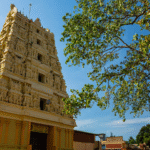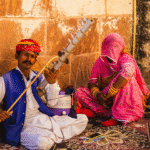
The metropolitan city of Mumbai is often touted as a city where people have no time. Filled with bustling offices, gigantic skyscrapers, and swanky malls, Mumbai is the face of modernization of India. Yet, there is a part of Mumbai that is still rooted in its old heritage and culture. This other side of Mumbai will show you the best of the colonial past, and the way it has been preserved. From gothic buildings to old villages, the Heritage Tour of Mumbai will show you a world away from the huge buildings and the posh flyovers.
Here are some of the places that still reflect the heritage of Mumbai:
To explore the heritage of Mumbai, you need to reach the famous Fort area. Fort is located at South Bombay, and now marks the colonial past of this city. From the moment you come here, you will see a change in architecture. It is like entering into an old town that is still in the colonial ages. From huge gothic monuments to age-old colleges that are still stuck in the past, the area of Fort will remind you of when Mumbai was Bombay.
This area was developed by the Britishers, hence, you will still find ancient restaurants, buildings with colonial architectures, and statues of the past.
Just take a quick stroll through the entire area. Everything here is so lavish and so ghetto, and so startlingly different from the rest of Mumbai, that is populated with skyscrapers. Even popular fashion brands like Zara and Westside also have their shops inside buildings that are reminiscent of the past in their architectural styles.
If you want to visit the Fort area, then it is highly recommended that you come here through the CSMT station. The Chhatrapati Shivaji Maharaja Terminus was once called the Victoria Terminus. This colossal station is now one of the main stations of Mumbai for both locals and long-distance trains. Enter this palatial station and find yourself greeted by stained glasses, magnificent pillars, and sculptures that hold this place together.
The exterior of this station is even more exotic. With a mix of Saracenic and Gothic architecture, the Victoria Terminus, as it is still fondly called, is the perfect testimony of how Mumbai has still preserved its past.
CSMT station also has a lovely museum inside, so make sure you visit it to know more about the history and life of Mumbai.
Once you exit the station, you will be flooded with an old town like vibe. There are wonderful old-style monuments, and a statue to mark your visit to the Bombay side of Mumbai.
You can walk over to heritage places like St. Xaviers College, the Press Club of India, the office of Times of India and the iconic Kyani’s restaurant.
To continue on your heritage tour of mumbai, hire a cab (fondly called Kaali Peelis) and make your way to the famous Asiatic Library. This regal library is colored in all white and has the most iconic steps of Mumbai. It was established in 1804, and now has one of the best collections of old and new books. This place has served as a wonderful backdrop for many Bollywood films, so be sure to sit down on those stairs and take a memorable photograph.
After a quick visit to the Asiatic Library, make your way to the rolling green park located right at the heart of Mumbai. It is satiated quite close to the Asiatic Library as well. This beautiful garden is a lovely recourse from the hustle-bustle and traffic of Mumbai. You will often find, impromptu jam sessions, a reading workshop and even some sale poetry going on in this garden.
You should also walk towards the palatial Horniman’s Circle from here and enjoy a hot cup of coffee at the most heritage like Starbucks located here. The Horniman Circle’s also has some posh and high end retails shops.
Start walking again from Horniman’s Circle, and cross the Mumbai Samachar Building, to reach a different side of Fort. This place is flooded with branches of all the financial banks that you can even think of. All of then are situated in buildings that will remind you to have the colonial days. As you keep walking, you will come across the famous St. Thomas Cathedral Church, which has been here since 1718. This ancient church was the first Anglican Church in Mumbai, making is highly revered and important.
The iconic Flora Fountain has served as a great landmark for many years and continues to do so. This exotic looking sculpture is headed by a Roman Goddess and is an architectural marvel. It was constructed in 1864 and has become quite an icon on Mumbai. Now called the Hutatma Chowk, it also witnessed a lot of bloodshed during the fight for a separate Maharashtra state in the past. There are some second hand book stalls also by the streets opposite the flora fountain.
Keep walking from the Flora Fountain, and soon you will be greeted by an elegant black horse statue that stands out in the traffic-choked area. This place is called Kala Ghoda. There is a labyrinth of lanes and mazes in this area, which is brimming with cutesy cafes and fine restaurants. Each lane will lead you to some of the hidden gems of Mumbai.
It is quite a happening place and a great place to enjoy some hearty meals. This is also the area where the iconic Kala Ghoda Festival takes place. Try to coincide your vacation at Mumbai with the Kala Ghoda festival dates, to witness the magical festival.
After a quick lunch at Kala Ghoda, make your way to the famous Oval Maidan. This huge ground stretches as far as your eyes can see, and is one of the most famous cricket pitches. Home to popular players like Sachin Tendulkar and Sunil Gavaskar, this gem of Mumbai is surrounded by some famous buildings including the Wilson College and the Clock Tower. The Oval Maidan is always crowded with cricket fanatics, and you can only imagine the blood, sweat, and tears that this ground has witnessed over the years
Walk this entire, and witness some more wonderful buildings like the Mumbai Police Headquarters and the Bombay High court.
Once you finish a quick round of this area, make your way to the populous Colaba Street. Known as Colaba Causeway, this area is filled with a cacophony of laughers, joy, and intense bargaining. It is a paradise for shoppers. Bustling with street vendors, and wonderful cafes, Colaba Causeway is definitely where all the action takes place.
This place also has the famous Leopold Cafe, the Mondegar Cafe, and Colaba Social to fulfill all your foodie dreams.
After a wondrous shopping spree at the overcrowded Colaba Causeway, and reach the icon of Mumbai- The Gateway of India. This colossal gate was also erected during the colonial times. This wonderful structure is rivaled only by the total Taj Mahal Hotel that is located right opposite the Gateway. Come here at night, to witness both these measuring architectural marvels in their fullest glories.
To continue to your heritage walk, visit Bandra the next day. This posh area is home to many heritage sites as well. More into the modern realm, Bandra is home to what Mumbai was after the colonisers had left.
Make your way to the famous Basilica Of Our Lady of The Mount, which is located atop a serene hill. One of the most popular churches in Mumbai, it is quite peaceful to be here. The architecture is also quite marvellous, and you will find many paintings inside the church that depict the life of Jesus. You can just sit in peace inside the church for some time, before continuing on your journey.
This hidden jewel of Mumbai is often missed by tourists who come here to see the heritage of Mumbai. The Bandra Graffiti Walk comprises of an entire stretch of roads, alleys, and walls that are covered by playful and colorful graffiti. You have to find your way through the narrow lanes to reach this area, but once you do, you won’t stop relishing the vibrant walls and the movie posters that are so intricately painted on the walls.
These lanes will also lead you to the Fishermen’s village in Bandra, which is a completely different side of Mumbai. Witness little huts, and colorful bungalows that dot this lane. You can also interact with these fishermen and women, who have been in Mumbai since time immemorial. These are the ones who make the heritage of Mumbai more authentic and real.
All of these places are deeply rooted in the making of Mumbai. All of them tell a story about the past of Mumbai and how it become what it is today. To understand the significance of the heritage monuments, you should read or talk to the locals, who will never get tired of reminiscing about the good old Bombay. So, just ditch the high-end malls and give yourself a chance to see the beauty of traditional Bombay.

11 Ancient Temples in Palakkad Kerala for a Soulful Spiritual Journey
01 Dec 2025
12 Beautiful Apple Orchard Destinations in India for a Scenic Mountain Getaway
01 Dec 2025
100 Amazing Facts about Rajasthan That Prove Rajasthan Is Awesome!
27 Nov 2025
12 Best Destinations for Spiritual Trekking in the Himalayas
26 Nov 2025
Top 10 Beaches in Thailand to Have a Dream Vacation
25 Nov 2025